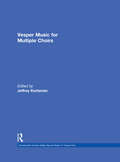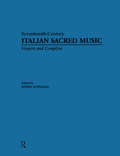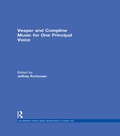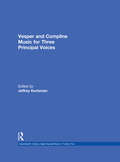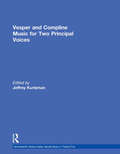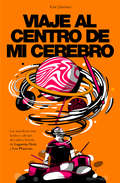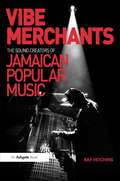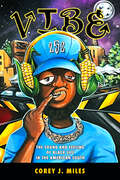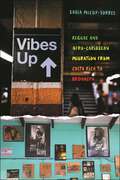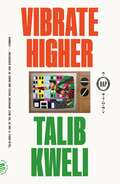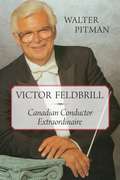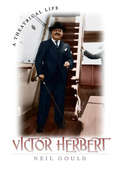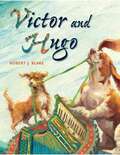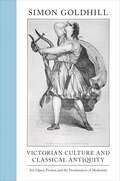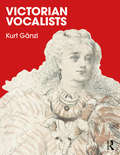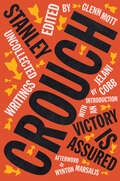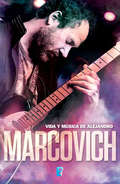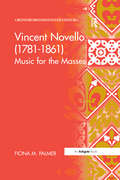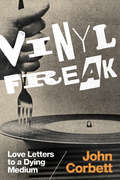- Table View
- List View
Vesper and Compline Music for Four Principal Voices: Agostino Agazzari, Giovanni Francesco Anerio, Giovanni Battista Biondi da Cesena, Maurizio Cazzati, Antonio Cifra, Chiara Margarita Cozzolani, Bonifazio Graziani, Giovanni Legrenzi, Isabella Leonarda, Tarquinio Merula, Lodovico Viadana (Seventeenth Century Italian Sacred Music In Twenty Five Ser. #14)
by Jeffrey Kurtzman Anne SchnoebelenFirst published in 1998. Routledge is an imprint of Taylor & Francis, an informa company.
Vesper and Compline Music for Multiple Choirs (Seventeenth Century Italian Sacred Music in Twenty Five #20)
by Jeffrey KurtzmanClassics of seventeenth-century Italian sacred music set in modern notation, this third part of Vesper and Compline Music for Multiple Choirs features works by Giacomo Giacobbi, Viriglio Mazzochi, Tarquinio Merula and Francesco Soriano.
Vesper and Compline Music for Multiple Choirs (Seventeenth Century Italian Sacred Music in Twenty Five)
by Jeffrey KurtzmanClassics of seventeenth-century Italian sacred music set in modern notation, this second part of Vesper and Compline Music for Multiple Choirs features works by Francesco Cavalli, Giovanni Legrenzi, Natale Monferrato, Agostino Steffani, Lorenzo Penna, Giovanni Paolo Colonna and Giovanni Paolo Colonna.
Vesper and Compline Music for One Principal Voice: Vesper & Compline Psalms & Canticles for One & Two Voices (Seventeenth Century Italian Sacred Music in Twenty Five #11)
by Jeffrey KurtzmanThis volume is part of a series of 25 full-score volumes of 17th-century Italian sacred music, a repertoire that has largely been unavailable for study or performance. It includes a comprehensive historical and biographical introduction, focuses on composers significant in their own time, and offers modern notation for contemporary performers.
Vesper and Compline Music for Three Principal Voices (Seventeenth Century Italian Sacred Music in Twenty Five)
by Jeffrey KurtzmanFirst Published in 1998. Routledge is an imprint of Taylor & Francis, an informa company.
Vesper and Compline Music for Two Principal Voices: Vesper And Compline Music For Two Principal Voices (Seventeenth Century Italian Sacred Music in Twenty Five #12)
by Jeffrey Kurtzman Anne SchnoebelenThis volume is part of a series of 25 full-score volumes of 17th-century Italian sacred music, a repertoire that has largely been unavailable for study or performance. It includes a comprehensive historical and biographical introduction, focuses on composers significant in their own time, and offers modern notation for contemporary performers.
Vevishaal (The Promised Hand)
by Ashok Meghani Jhaverchand Kalidas MeghaniTwo merchant families pledge to marry their children Sukhlal and Sushila to each other when the two come of age. Without taking sides, Vevishaal tells the story of the ensuing struggle between a wealthy, ruthless man and his presumed meek adversaries.
Viaje al centro de mi cerebro: Las anécdotas más ácidas y salvajes del icónico batería de Lagartija Nick y Los Planetas.
by Eric JiménezTras Cuatro millones de golpes, el mejor batería español de pop-rock relata sus historias más ácidas y salvajes de sus giras con Los Planetas y Lagartija Nick. Leer este libro es como viajar durante una semana en el motor de un autobús. Un libro que mediante kilómetros de historias dentro de la furgoneta en la que van de gira Los Planetas o Lagartija Nick, a pie por las calles de Granada o incluso en disolución por el efecto de algún psicotrópico nos descubre el centro del cerebro del batería más legendario de este país. Un recorrido divertido y surrealista que podría ser el viaje iniciático de un héroe y, sin embargo, es el de un rockero (que quizá sea lo mismo). Reseñas:«Eric escribe para poner negro sobre blanco una aventura que por momentos se le antoja inconcebible, la de estar vivo.»Eldiario.es «Un libro divertido, sincero, revelador de la escena musical de los noventa y dos mil, estupendamente narrado.»El País «Hará pasar un buen rato a todos esos que veneran, y con más razón que un santo granadino, a uno de los tipos más peculiares, geniales y de verdad del mejor tinglado indie de por aquí.»Mondosonoro «Escribe, como él dice, porque lo ha pasado de puta madre, pero también las ha pasado putas.»El Español Los lectores han dicho...«Todo lo que puedas imaginar se queda corto, tienes que leerlo.» «¡Bienvenido a la locura elevada a la máxima potencia!» «Divertido, honesto, tierno y desgarrador.»
Vibe Merchants: The Sound Creators Of Jamaican Popular Music (Ashgate Popular and Folk Music Series)
by Ray HitchinsVibe Merchants offers an insider’s perspective on the development of Jamaican Popular Music, researched and analysed by a thirty-year veteran with a wide range of experience in performance, production and academic study. This rare perspective, derived from interviews and ethnographic methodologies, focuses on the actual details of music-making practice, rationalized in the context of the economic and creative forces that locally drive music production. By focusing on the work of audio engineers and musicians, recording studios and recording models, Ray Hitchins highlights a music creation methodology that has been acknowledged as being different to that of Europe and North America. The book leads to a broadening of our understanding of how Jamaican Popular Music emerged, developed and functions, thus providing an engaging example of the important relationship between music, technology and culture that will appeal to a wide range of scholars.
Vibe: The Sound and Feeling of Black Life in the American South (Margaret Walker Alexander Series in African American Studies)
by Corey J. MilesWhere exactly does the South begin and end? Current maps are too rigid to account for the ways Black people have built the South while being simultaneously excluded from it. Drawing from the different ways Black artists in the 2-5-2 area code in North Carolina use "vibe" as a mode of knowing and communication, author Corey J. Miles illustrates how Black feeling and unfeeling offer entry points into the contemporary South that challenge static and monolithic notions of the region. Placing the local artists in conversation with other southern cultural creators such as 2 Chainz, Rod Wave, and Rapsody, these ethnographic narratives demonstrate that there are multiple Souths, with overlapping and distinct commitments to working through pain, sound, and belonging. In Vibe: The Sound and Feeling of Black Life in the American South, Miles narrates how southern Black sound, feeling, and being is constantly policed, surveilled, and criminalized. In doing so, he re-narrates the region as the "carceral South," to capture the ways people in the South and beyond can feel the emotional weight of the criminalization of Blackness. Pain music, a subgenre of trap music, is used to take the listener to moments of violence to allow them to hear the desires, anger, and silences that bind Black life in community. Through conceptions of ratchet, hood, and ghetto, Black artists turn away from respectable images and unmap the South. In trap music, they move the South to a space where multiple modes of being find respect and care.
Vibes Up: Reggae and Afro-Caribbean Migration from Costa Rica to Brooklyn
by Sabia McCoy-TorresExamines reggae culture as an expression of cultural, racial, and gender empowerment in the West Indian DiasporaIn popular media Caribbean culture has either been reduced to stereotypes of laziness, marijuana, and reggae music, or conversely, to an identity centered around a refutation of colonialism. Both are oversimplifications, and do not explain the enduring Caribbean identity and empowerment throughout the diaspora. Vibes Up offers an exploration of Caribbean culture as it is felt, understood, and expressed, centered on research conducted in Brooklyn and Costa Rica.Sabia McCoy-Torres demonstrates how reggae culture—which encompasses the music and performance modes of both “roots” and “dancehall”—helps to shed light on dynamics relating to migration, diaspora, queerness, Blackness, and Caribbean cultural subjectivity. Through an examination of elements of the Black outdoors, including nightlife venues, sidewalks, and streets in front of homes, the book shows the important role that reggae plays in articulating the frustrations of migration, establishing community and belonging, and forming transnational relationships.Although reggae’s creators and producers are often perceived as homophobic, Vibes Up also offers a more nuanced examination of the transforming relationships between hetero and LGBTQ+ people in reggae spaces and the accommodation of an array of queer intimacies. The framing of Caribbean Blackness as an expression of perseverance, agency, joy, and the erotic, as opposed to a reaction to colonization, oppression, and enslavement, is a distinctly important and timely view.
Vibrate Higher: A Rap Story
by Talib KweliFrom one of the most lyrically gifted, socially conscious rappers of the past twenty years, Vibrate Higher is a firsthand account of hip-hop as a political forceBefore Talib Kweli became a world-renowned hip-hop artist, he was a Brooklyn kid who liked to cut class, spit rhymes, and wander the streets of Greenwich Village with a motley crew of artists, rappers, and DJs who found hip-hop more inspiring than their textbooks (much to the chagrin of the educator parents who had given their son an Afrocentric name in hope of securing for him a more traditional sense of pride and purpose). Kweli’s was the first generation to grow up with hip-hop as established culture—a genre of music that has expanded to include its own pantheon of heroes, rich history and politics, and distinct worldview.Eventually, childhood friendships turned into collaborations, and Kweli gained notoriety as a rapper in his own right. From collaborating with some of hip-hop’s greatest—including Mos Def, Common, Kanye West, Pharrell Williams, and Kendrick Lamar—to selling books out of the oldest African-American bookstore in Brooklyn, ultimately leaving his record label, and taking control of his own recording career, Kweli tells the winding, always compelling story of the people and events that shaped his own life as well as the culture of hip-hop that informs American culture at large.Vibrate Higher illuminates Talib Kweli’s upbringing and artistic success, but so too does it give life to hip-hop as a political force—one that galvanized the Movement for Black Lives and serves a continual channel for resistance against the rising tide of white nationalism.
Vibrazioni Rock
by Daniel IchbiahNatale 1976: il nuovo album degli Eagles arriva sugli scaffali. Una settimana dopo, un milione di copie vengono vendute. Eppure nessuno sa che Hotel California, puro momento di grazia musicale, è nata in un‘atmosfera in cui c’era una tensione infernale. In quel periodo, c’era burrasca tra i membri del gruppo e spesso arrivano addirittura alle mani dopo un concerto. È proprio vero, le canzoni di punta del rock hanno tutte la loro storia e sono affascinanti. Like a Rolling Stone, Stairway to Heaven, Mélodie Nelson, Sultans of Swing, Losing my religion, oppure Un autre monde e Smells Like Teen Spirit e molti altri successi mitici non sono altro che il risultato perfetto della passione e del romanticismo che solo il rock poteva creare. Dietro le quinte delle grandi etichette, guadagnando la fiducia sia degli autori che dei musicisti, Daniel Ichbiah ha fatto le sue ricerche e ha ricostruito il puzzle del successo dagli Stones ai Nirvana passando per Bashung. Che dire? Raccontare la genesi dei successi del rock non è stato facile. Ma più di un lettore lo ha ammesso: è impossibile lasciare andare queste pagine una volta che ci si è avventurati nei meandri di molte canzoni diventate mitiche. Ricco di rivelazioni, impregnato di testimonianze esclusive, questo documento d'eccezione ci trascina nel cuore delle canzoni che hanno segnato la nostra epoca. Raccontandoci l'elaborazione e le saghe di successi leggendari, Vibrazioni Rock ci fa rivivere il brivido di decenni di storia del rock.
Victor Feldbrill: Canadian Conductor Extraordinaire
by Walter PitmanVictor Feldbrill is an account of the life and cultural contribution of one of Canada’s most talented conductors. Born in 1924, he made his Toronto Symphony conducting debut at 18. He went on to become the artistic director of the Winnipeg Symphony, a conductor with the Toronto Symphony, and a guest conductor of virtually every major symphony orchestra in Canada. Feldbrill was also the first conductor-in-residence at the University of Toronto’s Faculty of Music from 1968 to 1982. However, what really set Feldbrill apart was his limitless enthusiasm and support of Canadian music and young musicians, as well as his insistence on playing the music of Canadian composers despite the reluctance of some orchestral managers and the initial opposition of audiences at the time. In doing so he reached out to young people and trained many to take their places as members of Canadian orchestras from coast to coast.
Victor Herbert: A Theatrical Life
by Neil GouldVictor Herbert is one of the giants of American culture. As a musician, conductor, and, above all, composer, he touched every corner of American musical life at the turn of the century, writing scores of songs, marches, concerti, and other works. But his most enduring legacy is on a different kind of stage, as one of the grandfathers of the modern musical theater.Now, Victor Herbert has the biography he deserves. Neil Gould draws on his own experience as a director, producer, and scholar to craft the first comprehensive portrait in fifty years of the Irish immigrant whose extraordinary talents defined the sounds of a generation and made contemporary American music possible.Mining a wealth of sources—many for the first time—Gould provides a fascinating portrait of Herbert and his world. Born in Dublin in 1859, Herbert arrived in the United States in 1886. From his first job in the orchestra pit of the Metropolitan Opera, Herbert went on to perform in countless festivals and concerts, and conduct the Pittsburgh Orchestra. In 1894, he composed his first operetta, Prince Ananias, and by the time of his death in 1924, he’d composed forty-two more—many of them, such as Naughty Marietta, spectacular Broadway hits. Along the way, he also wrote two operas, stage music for the Ziegfeld Follies, and the first full score for a motion picture, The Fall of a Nation.Gould brilliantly blends the musical and the theatrical, classical and popular, the public and the private, in this book. He not only gives a revealing portrait of Herbert the artist, entrepreneur, and visionary, but also recreates the vibrant world of the Herbert’s Broadway. Gould takes us inside the music itself—with detailed guides to each major work and recreations of great performances. He also makes strong connections between Herbert’s breakthrough compositions, such as the operetta Mlle. Modiste, and the later contributions of Rudolf Friml,Sigmund Romberg, Jerome Kern and other giants of the musical theater.As exuberant as Herbert himself, this book is also a chronicle of American popular culture during one of its most creative periods. For anyone enraptured by the sound of the American musical, this book is delightfully required reading.
Victor and Hugo
by Robert J. BlakeFrom the creator of beloved stories about dogs--their bravery, loyalty, and companionship--comes a celebration of music, friendship, Paris, and puppies set against an exquisitely illustrated Parisian backdrop!On a beautiful bridge in Paris, performing dogs Victor and Hugo dance and sing as their Maestro plays his music. But when Maestro&’s accordion falls over the side of the bridge and onto a barge, the music stops—not only for Maestro, but for everyone! Victor and Hugo must rescue the accordion, and as they chase after it, they know that saving the accordion for their Maestro will mean saving music for the entire city as well. In this rollicking adventure through Paris, Victor and Hugo show us that friendship and music can combine to create the greatest magic of all.Praise for Victor and Hugo:"A high-energy, exuberant romp through the City of Light. For lovers of art, music, and action-packed adventure."--School Library Journal
Victorian Culture and Classical Antiquity: Art, Opera, Fiction, and the Proclamation of Modernity (Martin Classical Lectures #29)
by Simon GoldhillHow did the Victorians engage with the ancient world? Victorian Culture and Classical Antiquity is a brilliant exploration of how the ancient worlds of Greece and Rome influenced Victorian culture. Through Victorian art, opera, and novels, Simon Goldhill examines how sexuality and desire, the politics of culture, and the role of religion in society were considered and debated through the Victorian obsession with antiquity. Looking at Victorian art, Goldhill demonstrates how desire and sexuality, particularly anxieties about male desire, were represented and communicated through classical imagery. Probing into operas of the period, Goldhill addresses ideas of citizenship, nationalism, and cultural politics. And through fiction--specifically nineteenth-century novels about the Roman Empire--he discusses religion and the fierce battles over the church as Christianity began to lose dominance over the progressive stance of Victorian science and investigation. Rediscovering some great forgotten works and reframing some more familiar ones, the book offers extraordinary insights into how the Victorian sense of antiquity and our sense of the Victorians came into being. With a wide range of examples and stories, Victorian Culture and Classical Antiquity demonstrates how interest in the classical past shaped nineteenth-century self-expression, giving antiquity a unique place in Victorian culture.
Victorian Vocalists
by Kurt GanzlVictorian Vocalists is a masterful and entertaining collection of 100 biographies of mid- to late-19th-century singers and stars. Kurt Gänzl paints a vivid picture of the Victorian operatic and concert world, revealing the backgrounds, journeys, successes, failures and misdemeanours of these singers. This volume is not only an outstanding reference work for anyone interested in vocalists of the era, but also a compelling, meticulously researched picture of life in the vast shark tank that was Victorian music.
Victory Is Assured: Uncollected Writings of Stanley Crouch
by Stanley CrouchThe grievous loss of Stanley Crouch, one of America’s most renowned intellectuals, is underscored by the posthumous appearance of these remarkable essays. With Stanley Crouch’s untimely death in 2020, American literature lost “a critic without peer” (Ta-Nehisi Coates). Born in Los Angeles in 1945, Crouch—a towering stylist, fearless columnist, and without question, one of the finest jazz critics of all time—was Rabelaisian both in stature and in intellectual appetite. Beloved yet cantankerous, Crouch delighted and enflamed the passions of his readers in equal measure, whether writing about race, politics, literature, or music. In these essays—some discovered on his computer, unpublished until now—Crouch tackles subjects ranging from Malcolm X (“a thorned bud standing in the shadow of sequoias”) to the films of Quentin Tarantino (“With Django, Tarantino has slipped down . . . into a shallow and bloodstained hip-hop turn that his own best work has well-refuted”). Introduced by Jelani Cobb, with an afterword by Wynton Marsalis, and collected by his longtime editor Glenn Mott, Victory Is Assured canonizes the legacy of an inimitable, indispensable American critic.
Vida y Música de Alejandro Marcovich
by Alejandro MarcovichEn este libro, Alejandro Marcovich, el legendario guitarrista de Caifanes, uno de los grupos más influyentes del rock en español, reproduce su andar a través de la música, recuerda su infancia y sus primeras canciones. En esta autobiografía, el músico nos relata su vida y cómo se convirtió en uno de los pocos guitarristas con un sonido propio, identificable desde las primeras notas, capaz de hacer hablar a la guitarra desde lo más dulce hasta lo más desgarrado y extremo, para transformarse en una inspiración para varias generaciones.
Villager Jim's Moorland Wildlife
by Villager JimVillager Jim, the famous Peak District photographer, takes us on a journey to his very favorite places on the moors surrounding the Peak District National Park, where he lives. From wonderful wild deer to breathtaking buzzards and other birds of prey, Jim allows us a glimpse of his daily moorland travels with all the abundant wildlife that lives in that part of the world. Jim often concedes that it is his most favorite place on earth, being out alone with his camera within this unforgiving landscape, watching the sun rise on the horizon, whilst at the same time, seeing stags wander, grazing on the moorland. It is here also that many of his favorite birds of prey abound. And, of course, he is there to capture the beautiful landscape shots rolling in mists or washed in the golden light of dawn.
Vincent Novello: Music for the Masses (Music in Nineteenth-Century Britain)
by Fiona M. PalmerToday Vincent Novello (1781-1861) is remembered as the father of the music-publishing firm. Fiona Palmer's evaluation of Novello the man and the musician in the marketplace draws on rich primary sources. It is the first to provide a rounded view of his life and work, and the nature of his importance both in his own time and to posterity. Novello's early musical training, particularly his experience of music-making in London's embassy chapels, influenced him profoundly. His practical experience as director of music at the Portuguese Embassy Chapel in Mayfair informed his approach to editing and arranging. Fundamental moral and social attitudes underpinned Novello's progress. Ideas on religion, education and the function of family and friendship within society shaped his life choices. The Novello family lived in turbulent times and was widely-read, discussing politics and religion and not only the arts at its social gatherings. Within Vincent and Mary Novello's close circle were radical thinkers with republican views - such as Leigh Hunt and Charles Cowden Clarke - who saw sociability as a means of reorganizing society. Thematic studies focus on Novello as practical musician and educator, as editor, and as composer. His connections with institutions such as the Covent Garden and Pantheon Theatres, the Philharmonic Society and Moorfields Chapel, together with his adjudicating and teaching activities, are examined. In his wide-ranging editorial work Novello found his true vocation positioning himself as preservationist, pioneer and philanthropist. His work as composer, though unremarkable in quality, mirrored the demands and expectations of his consumers. Novello emerges from this study as a visionary who single-mindedly pursued greater musical knowledge for the benefit of everyone.
Vincenzo Bellini: A Guide to Research (Routledge Music Bibliographies)
by Stephen WillierThis comprehensive bibliography and research guide details all the works currently available on Vincenzo Bellini, the Italian opera composer best known for his work Norma, which is still regularly performed today at Covent Garden and by regional opera companies. 2001, the bicentennial anniversary of Bellini's death, saw several concerts and recordings of his work, raising his academic profile. This volume aims to meet the research needs of all students of Bellini in particular.
Vinyl Age: A Guide to Record Collecting Now
by Max BrzezinskiFrom Carolina Soul Records, one of the world's largest online record sellers, comes the definitive guide to every aspect of record collecting in the digital era. Any music fan knows that there's nothing like the tactile pleasure of a record. Even with access to a variety of streaming services, digital technology has paved the way for the analog revival; from multiplatinum megahits to ultra-obscure private presses, millions of records are available for purchase from all over the world. Vinyl Age is the ultimate post-internet guide to record collecting.Written by Max Brzezinski of Carolina Soul Records, one of the world's largest high-end record dealers, Vinyl Age combines an engaging narrative and incisive analysis to reveal the joys and explain the complexities of the contemporary vinyl scene. Brzezinski demystifies the record game and imparts the skills essential to modern record digging -- how to research, find, buy, evaluate, and understand vinyl in the twenty-first century.
Vinyl Freak: Love Letters to a Dying Medium
by John CorbettFrom scouring flea markets and eBay to maxing out their credit cards, record collectors will do just about anything to score a long-sought-after album. In Vinyl Freak, music writer, curator, and collector John Corbett burrows deep inside the record fiend’s mind, documenting and reflecting on his decades-long love affair with vinyl. Discussing more than 200 rare and out-of-print LPs, Vinyl Freak is composed in part of Corbett's long-running DownBeat magazine column of the same name, which was devoted to records that had not appeared on CD. In other essays where he combines memoir and criticism, Corbett considers the current vinyl boom, explains why vinyl is his preferred medium, profiles collector subcultures, and recounts his adventures assembling the Alton Abraham Sun Ra Archive, an event so all-consuming that he claims it cured his record-collecting addiction. Perfect for vinyl newbies and veteran crate diggers alike, Vinyl Freak plumbs the motivations that drive Corbett and collectors everywhere.

